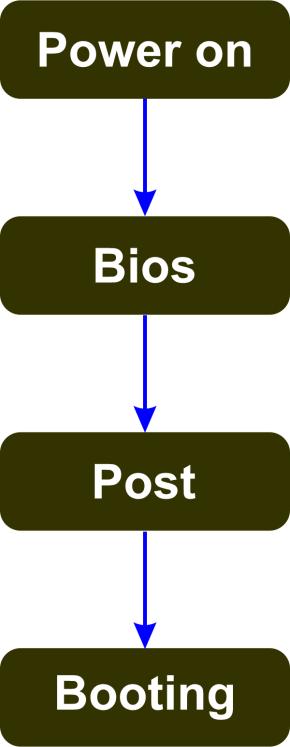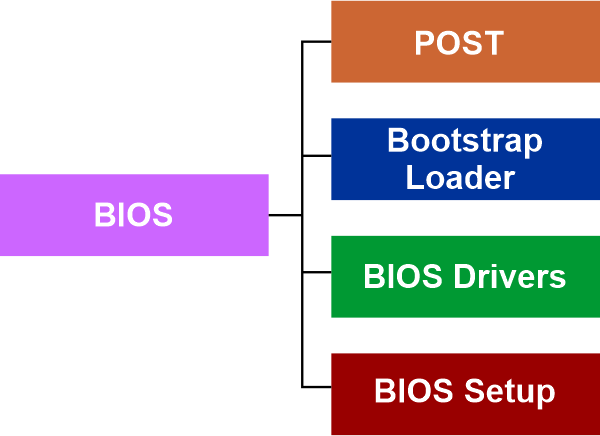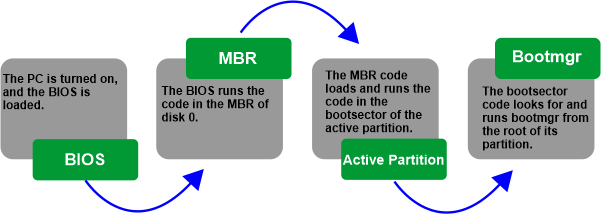What is BIOS?
BIOS stands for Basic Input/Output System. It is firmware that controls the basic functions of a computer, such as booting the system and communicating with the hardware. It is stored on a chip on the motherboard and is responsible for performing a power-on self-test (POST) when the computer is first turned on, and then locating and loading the operating system from the hard drive or another storage device. It also provides a user interface to configure the system's hardware settings and update the BIOS firmware. Furthermore, it acts as a bridge between the system hardware and the operating system.

Function of BIOS
The BIOS (Basic Input/Output System) has several functions, which include:
Booting the computer: The BIOS performs a power-on self-test (POST) when the computer is turned on and locates and loads the operating system from the hard drive or another storage device.
Providing a basic interface for hardware: It provides a basic interface for communicating with the computer's hardware components, such as the keyboard, mouse, and other input/output devices.
Configuring hardware settings: The BIOS allows users to configure settings for the computer's hardware, such as the system clock, boot order, and power management settings.
Managing system resources: The BIOS manages system resources such as memory, IRQs, and DMA channels.
Power management: The BIOS controls the computer's power management, such as the power-saving features and sleep/hibernation modes.

Types of BIOS
There are several types of BIOS, which are as follows:
Legacy BIOS: This is the traditional BIOS firmware that has been used in computers for many years, and it is no longer in development and is being replaced by UEFI.
UEFI (Unified Extensible Firmware Interface): UEFI is a newer BIOS firmware that has largely replaced Legacy BIOS. It offers more advanced features such as support for larger hard drives and faster boot times.
Open-source BIOS: An open-source BIOS is available for anyone to view and modify the source code. This allows developers to customize the BIOS to their specific needs.
Vendor-specific BIOS: These are BIOS that are specifically developed and provided by a particular hardware vendor, such as Dell or HP. They are usually tailored to the specific hardware and features of the vendor's computers.
Option ROM: An option ROM, sometimes called an expansion ROM, is a BIOS-like firmware used to initialize specific hardware components such as a network card or a graphics card.
BIOS-based firmware: This is firmware that is designed to run on top of the BIOS, such as system management firmware, embedded controller firmware, and graphics firmware.
Note: UEFI is considered a replacement for Legacy BIOS. It offers more advanced features, such as support for larger hard drives, faster boot times, and more security features.
Difference Between BIOS And UEFI
- BIOS (Basic Input/Output System) and UEFI (Unified Extensible Firmware Interface) are both firmware that controls the basic functions of a computer, such as booting the system and communicating with the hardware. However, there are some key differences between the two:
- Boot process: BIOS uses the Master Boot Record (MBR) to boot the system, while UEFI uses the GUID Partition Table (GPT). UEFI supports faster boot times and more flexible boot options.
- Hardware support: UEFI supports larger hard drives and more advanced hardware features than BIOS, such as support for Secure Boot, which helps to prevent malicious code from running on the system.
- User interface: UEFI has a graphical user interface (GUI), which makes it more user-friendly than BIOS.
- Security: UEFI has more robust security features than BIOS, such as secure boot and built-in encryption.
- Memory limit: BIOS is limited to 1 megabyte of memory, while UEFI supports more memory.
BIOS Modes
There are several BIOS modes or settings that can be configured, which include:
Legacy BIOS mode: This is the traditional BIOS firmware mode that has been used in computers for many years, and it is no longer in development and is being replaced by UEFI.
UEFI mode: This newer BIOS firmware mode has largely replaced Legacy BIOS. It offers more advanced features, such as support for larger hard drives and faster boot times.
Secure Boot mode: This is a security feature available in UEFI mode; it helps prevent malicious code from running on the system by verifying the operating system's and other software's digital signature before it is executed.
Compatibility Support Module (CSM) mode: This feature allows the UEFI firmware to support Legacy BIOS mode; it enables the system to boot using Legacy BIOS boot methods and load Legacy BIOS-only operating systems.
AHCI/RAID mode: This mode is related to the storage controller; AHCI (Advanced Host Controller Interface) mode is a standard for connecting storage devices, and RAID (Redundant Array of Independent Disks) mode is used for creating redundant arrays of disks for increased data reliability.
Hardware monitoring mode: This mode allows the BIOS to monitor the system's components' temperature, voltage, and fan speeds and alert the user if any values fall outside of safe ranges.
Power management mode: This mode allows the configuration of power-saving features such as sleep and hibernation modes and power-saving features like Intel SpeedStep or AMD Cool'n'Quiet.
How does BIOS Work?

BIOS (Basic Input/Output System) is firmware that controls the basic functions of a computer, such as booting the system and communicating with the hardware. It is stored on a chip on the motherboard. It is responsible for performing a power-on self-test (POST) when the computer is turned on and then locating and loading the operating system from the hard drive or another storage device.
When a computer is powered on, the BIOS performs a power-on self-test (POST) which checks the system's hardware components to ensure they are functioning properly. The BIOS will display an error message if any issues are detected during the POST. Once the POST is complete, the BIOS locates and loads the bootloader from the hard drive or another storage device, which in turn loads the operating system.
The BIOS also provides a basic interface for communicating with the computer's hardware components, such as the keyboard, mouse, and other input/output devices. It also allows users to configure computer hardware settings, such as the system clock, boot order, and power management settings.
Additionally, the BIOS manages system resources such as memory, IRQs, and DMA channels and controls the computer's power management, such as the power-saving features and sleep/hibernation modes.
What is BIOS Setting
BIOS settings are the configuration options available in the BIOS firmware of a computer. These settings allow users to control various aspects of the computer's hardware and behaviour, such as the system clock, boot order, and power management settings. Some common BIOS settings include:
Date and Time: Allows users to set the system clock and calendar.
Boot Order: Allows users to specify the order in which the computer attempts to boot from different devices, such as the hard drive, CD/DVD drive, or USB drive.
Security: Allows users to set a password to prevent unauthorized access to the BIOS settings.
Power Management: Allows users to configure settings such as sleep and hibernation modes and power-saving features like Intel SpeedStep or AMD Cool'n'Quiet.
Hardware settings allow users to configure CPU fan speed, memory timing and voltage, and SATA controller mode.
These settings can be accessed by pressing a specific key during the computer's boot process, usually Del, F2, or Esc. It is important to be careful when modifying the BIOS settings, as incorrect settings can cause the system to become unstable or even prevent it from booting.
Upgrading of BIOS
Upgrading the BIOS, also known as flashing the BIOS, involves replacing the current BIOS firmware with a newer version. This process is typically done to fix bugs, improve security, or add new features. Here is the general procedure for upgrading the BIOS:
- Download the latest BIOS firmware from the computer manufacturer's website or the BIOS firmware provider's website.
- Create a bootable USB drive or CD/DVD with the BIOS firmware update files.
- Restart the computer and enter the BIOS setup.
- Locate the option to update the BIOS; this can be called "Flash BIOS" or "Update BIOS."
- Follow the prompts to select the bootable USB drive or CD/DVD you created in step 2.
- The update process will begin, and the computer will restart several times. Do not interrupt the process.
- Once the update is complete, the computer will reboot, and the new BIOS version will be in effect.
It's important to follow the instructions provided by the computer manufacturer or BIOS firmware provider carefully, as a mistake during the update process could cause the computer to become unbootable. Also, it's recommended to back up important data before updating the BIOS.
BIOS Error Messages
BIOS error messages are codes or messages displayed by the BIOS when there is a problem with the computer's hardware or firmware. These error messages can indicate a wide range of issues, such as a malfunctioning component, a problem with the power supply, or a corrupted BIOS firmware. Some common BIOS error messages include:
"CMOS Checksum Error": This message indicates that the BIOS settings have become corrupted or that the CMOS battery is low.
"Disk Boot Failure": This message indicates that the computer is unable to locate the bootable device or that the bootable device is malfunctioning.
"Keyboard Error" or "Keyboard not Found": This message indicates that the keyboard is not properly connected or is malfunctioning.
"No Memory Detect": This message indicates that the computer is not detecting any memory or that the memory is not properly installed.
"BIOS ROM checksum error": This message indicates that the BIOS firmware is corrupted.
"CPU overheating": This message indicates that the CPU temperature is too high; a malfunctioning cooling system or a clogged air filter may cause it.
"Invalid system disk" or "non-system disk or disk error": This message indicates that the computer is not detecting a bootable device or that the bootable device is malfunctioning.
"System halted": This message indicates that the system has encountered a critical error and has stopped.
Note: these error messages may vary depending on the BIOS firmware version and the computer manufacturer, and the specific meanings of the messages may also differ. It's also important to refer to the computer's documentation or the manufacturer's website for more information on the specific error message and the recommended troubleshooting steps.